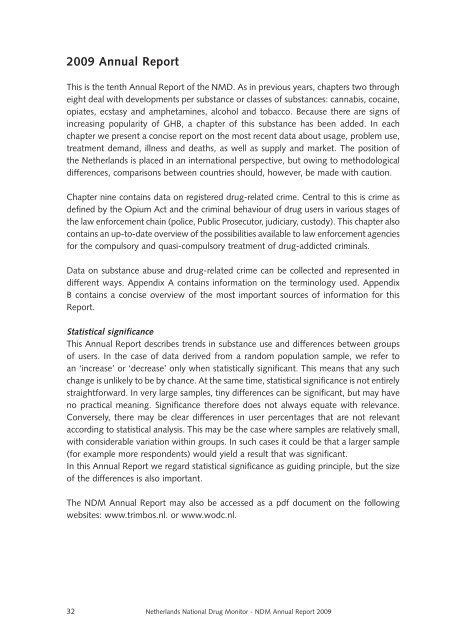Netherlands National Drug Monitor - Research and Documentation ...
Netherlands National Drug Monitor - Research and Documentation ...
Netherlands National Drug Monitor - Research and Documentation ...
Create successful ePaper yourself
Turn your PDF publications into a flip-book with our unique Google optimized e-Paper software.
2009 Annual Report<br />
This is the tenth Annual Report of the NMD. As in previous years, chapters two through<br />
eight deal with developments per substance or classes of substances: cannabis, cocaine,<br />
opiates, ecstasy <strong>and</strong> amphetamines, alcohol <strong>and</strong> tobacco. Because there are signs of<br />
increasing popularity of GHB, a chapter of this substance has been added. In each<br />
chapter we present a concise report on the most recent data about usage, problem use,<br />
treatment dem<strong>and</strong>, illness <strong>and</strong> deaths, as well as supply <strong>and</strong> market. The position of<br />
the <strong>Netherl<strong>and</strong>s</strong> is placed in an international perspective, but owing to methodological<br />
differences, comparisons between countries should, however, be made with caution.<br />
Chapter nine contains data on registered drug-related crime. Central to this is crime as<br />
defined by the Opium Act <strong>and</strong> the criminal behaviour of drug users in various stages of<br />
the law enforcement chain (police, Public Prosecutor, judiciary, custody). This chapter also<br />
contains an up-to-date overview of the possibilities available to law enforcement agencies<br />
for the compulsory <strong>and</strong> quasi-compulsory treatment of drug-addicted criminals.<br />
Data on substance abuse <strong>and</strong> drug-related crime can be collected <strong>and</strong> represented in<br />
different ways. Appendix A contains information on the terminology used. Appendix<br />
B contains a concise overview of the most important sources of information for this<br />
Report.<br />
Statistical significance<br />
This Annual Report describes trends in substance use <strong>and</strong> differences between groups<br />
of users. In the case of data derived from a r<strong>and</strong>om population sample, we refer to<br />
an ‘increase’ or ‘decrease’ only when statistically significant. This means that any such<br />
change is unlikely to be by chance. At the same time, statistical significance is not entirely<br />
straightforward. In very large samples, tiny differences can be significant, but may have<br />
no practical meaning. Significance therefore does not always equate with relevance.<br />
Conversely, there may be clear differences in user percentages that are not relevant<br />
according to statistical analysis. This may be the case where samples are relatively small,<br />
with considerable variation within groups. In such cases it could be that a larger sample<br />
(for example more respondents) would yield a result that was significant.<br />
In this Annual Report we regard statistical significance as guiding principle, but the size<br />
of the differences is also important.<br />
The NDM Annual Report may also be accessed as a pdf document on the following<br />
websites: www.trimbos.nl. or www.wodc.nl.<br />
32 <strong>Netherl<strong>and</strong>s</strong> <strong>National</strong> <strong>Drug</strong> <strong>Monitor</strong> - NDM Annual Report 2009




